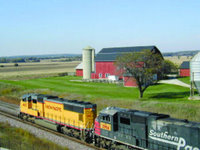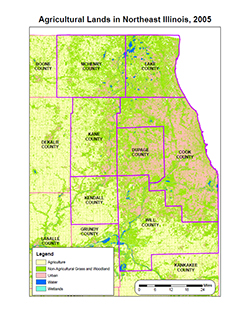Agricultural Preservation Strategy Paper
Agricultural Preservation Strategy Report Summary
 As the threats of food security and global climate change gain momentum, agricultural preservation is becoming increasingly popular, even in headlines of major newspapers. The objective of this strategy paper is to outline the importance of agriculture to northeastern Illinois and the costs and benefits associated with preservation. With an expected population growth of 2.8 million people, CMAP recognizes that new development will occur outside of the existing urban footprint. This strategy would prioritize the most valuable agricultural soils for preservation and promote balanced growth and conservation design principles in new greenfield developments.
As the threats of food security and global climate change gain momentum, agricultural preservation is becoming increasingly popular, even in headlines of major newspapers. The objective of this strategy paper is to outline the importance of agriculture to northeastern Illinois and the costs and benefits associated with preservation. With an expected population growth of 2.8 million people, CMAP recognizes that new development will occur outside of the existing urban footprint. This strategy would prioritize the most valuable agricultural soils for preservation and promote balanced growth and conservation design principles in new greenfield developments.
The Chicago Metropolitan Agency for Planning (CMAP) is responsible for developing the GO TO 2040 plan, a long-range plan for the region's future. This paper is meant to explore the issue of agricultural preservation to support CMAP's approach to this important topic in the GO TO 2040 plan.
A sample of findings:
Primary Land Use Impacts
- Concentrating growth in less sensitive areas will encourage more compact and contiguous development patterns and minimize the need for new infrastructure.
- Restrictions on land use may increase land value and affect the affordable housing investment.
Primary Environmental Impacts
- Limiting increases in impervious surfaces reduces stormwater runoff and erosion, helping to maintain the natural infiltration processes for purification. This improves soil and groundwater quality.
- Preserving agricultural areas can help preserve existing ecosystems by limiting new development areas.
|
Links
Related Links Map 
|